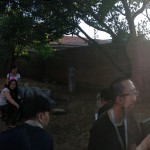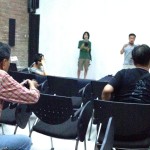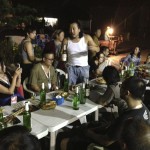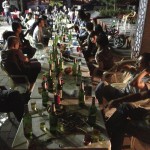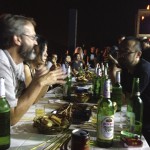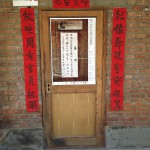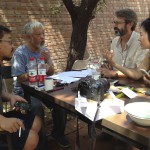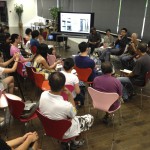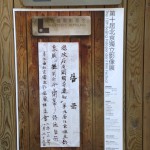Professor Abe Markus Nornes of University of Michigan wrote memorably about his visits to Yunfest in Yunnan and the China Documentary Festival in Songzhuang in “Bulldozers, Bibles, and Very Sharp Knives: The Chinese Independent Documentary Scene,” (Film Quarterly 63, no.1, 2009). This year, he happened to be in Songzhuang again for BIFF 2013, and has kindly supplied us with his report, which follows below with a gallery of photos.
Rambunctious Beyond the Sixth Ring
A. M. Nornes
Last month I was lucky enough to attend the Beijing Independent Film Festival in Songzhuang, my third visit to this haven of artists on the very edge of the city. I will go again. The tenacious rambunctiousness and hopefulness of this community of filmmakers and programmers is so admirable. It’s utterly bracing.
The festival’s opening night was fascinating, as predicted. Everyone was expecting the worst for weeks, after the Li Hsiangting Film Institute’s school was forcibly disbanded. I understand many people gave up on going, assuming the festival was doomed. What a mistake. Of course, something great would happen, no matter what.
By the evening before, word was out: the authorities had told the festival they could hold symposia and discussions, but show no films. I arrived late to the screening-less opening ceremony, passed a contingent of thuggish and plainly bored plain clothes cops, and then was ceremoniously whisked to the front row and then put on stage to greet the audience. That was a bit dramatic and unexpected! I basically said what I just wrote. The festival may be interrupted, but something interesting and important always happens at Songzhuang. My expectations were high, but as flexible as could be. It would be good, no matter what.
After introducing all the filmmakers, the ceremony ended and people gathered at the nearby Li Hsiangting Film Institute. Everyone hung out for a few hours, chatting in the courtyard and enjoying unusually clean and fresh air. Suddenly, on an abrupt cue from organizers, everyone filed into the institute’s brand new theater. However, no sooner had people taken their seats than the festival director Wang Hongwei dismissed everyone but the directors and a few international guests. So half the audience immediately left! When the door closed behind the last departing audience member, the organizers then announced their strategy: the festival sought permission from all the directors to pass out DVDs of their films. Guests and filmmakers could check out a package of DVDs to watch, on the condition of no copying. The police had said nothing about private viewing, so the idea was to watch as many films as possible in homes and then constantly regroup back at the Institute for discussions. I know of several artists and filmmakers who had opened their galleries or homes to people for film viewing in small groups. For example, the courtyard home of vivacious Inner Mongolian filmmaker Gu Tao (Aoluguya, Aoluguya) served as one screening and gathering site in the first couple days.
Gu Tao also presided over an ad hoc opening night dinner—a lively late night bash at an outdoor restaurant at one of the longest tables I have ever seen (upon arrival at the restaurant he issued the first order with a flourish: “A hundred skewers of meat for now!”). There was much singing, toasting and standing on tables. The raucous discussions featured predictable complaints about police interference, surveillance, phone tapping and the like. I sat with painter Han Tao, who claimed he had four plain clothes policemen tailing him 24/7. We must have looked skeptical, because he abruptly jumped up, ran to his car, and peeled out onto the main street. Just as swiftly, a car fired up and followed him. Han did a U-turn after 50 meters and the car tailed him back to the parking lot. He returned with a smug smile, having both demonstrated his predicament and undoubtedly ticked off the surveillance crew.
Not surprisingly, the second morning was quiet. Only a few people came to the Institute, assuming the festival was cancelled. I had lunch with the staff, who ended the meal with a curious and unusual conversation. They basically sat around wondering what to do. One person said they had at least one film that had actually passed censorship, so they could show those and the police shouldn’t be able to complain. Someone suggested sneaking in some more. Then Li Hsiangting said, “Let’s show them all!” Wang looked a little hesitant about that, having been the butt of much of the negotiations with authorities. The lunch ended inconclusively, leaving a collection of hopeful audience members hanging out in the courtyard, quietly chatting. About an hour or two later, a staff member suddenly appeared and announced that screenings of the opening night films would start immediately. It was 2:47 in the afternoon. Whoever was around filed in to one of the two theaters and opening night began the bright afternoon of Day Two.
On Day Three, screenings continued on an ad hoc basis. By Day Four, they began sticking to their schedule. Everyone expected the electricity to go off again (I heard they invested in a generator after having the juice cut off in the middle of last year’s opening), but obviously the police felt they did their job on opening night and were looking the other way. They surely knew what was going on. It was a textbook case of the nervously powerful negotiating their dominance with the powerless.
However, the festival continued to its conclusion. The audience was thin, first and foremost because word of the cancellation had spread widely and then was reiterated in the media even after they resumed screenings. However, there was speculation that the festival’s PR itself was to blame. Anticipating problems, the festival poster featured a photograph of last year’s cancellation notice, which had been pasted on the Institute’s front door. There was a special significance to this notice, as it was important to festival organizers that it was painted in Li Hsiangting’s own hand. This harked back to the famous 1989 exhibition of modernist art at the Chinese National Gallery of Art, which was also shut down by authorities and also featured a calligraphic cancellation notice painted by Li. To overtly make the connection, this year’s catalog cover was graced by a photograph of the 1989, painted on a board that Li saved over the years (it has been used to patch the roof of an artist friend, and Li recently discovered it in the rubble of his friend’s home upon demolition). Although the catalog cover and festival poster sent a powerful message about the continuing harassment of artists, it regrettably sent another message to today’s audiences: its own PR inspired audiences to give up and stay away.
In the title of this report, I called the independent filmmaking crowd “rambunctious.” It’s a perfect word. This is a festival with a reputation for the radical and the political, but it’s really more rambunctious. A word meaning “outrageously flamboyant,” “excessively exuberant,” or “difficult to manage or bring under control,” it fits the many activities of the Li Hsiangting Film Institute quite wonderfully because the place is marked by a fantastic heterogeneity of styles, modes, and politics (and/or a-politics). It’s very much about carving out an independent space for independent artists, and it’s just perplexing that the police care at all.
This was brought home to me just hours before the Opening Ceremony, at a meeting that ran long and caused my tardiness. I am researching a book on calligraphy in East Asian cinema, and was lucky to meet a group of art directors at one of the film studios in Beijing. Two of the participants were senior film artists in the official documentary world. Just out of curiosity, I told the veteran documentary filmmakers I was going to Songzhuang for the festival; had they ever heard of it? Nope. How about Wu Wenguang; know him? Nope. I guess that’s about as “underground” as you get.
- Audience members hanging on in the Li Hsiangting Film Institute courtyard after the opening ceremony.
- Wang Hongwei addressing the directors, proposing to convert the film festival into a dispersed, multi-nodal, semi-private DVD festival.
- Director Gu Tao presiding over an opening night bash, artist Han Tao sitting just left of him.
- The long, long table for the opening night dinner.
- Director Cong Feng talking to Akiyama Tamako and Markus Nornes at the opening night dinner.
- Door to one of two theaters at the Li Hsiangting Film Institute.
- One of many lively courtyard discussions: (from left) festival director Wang Hongwei, Li Hsiangting, Markus Nornes and Akiyama Tamako.
- Underground panel discussion launching a new book series by the Li Hsiangting Film Institute.
- The 2013 film festival poster of last year’s cancellation notice, pasted precisely where last year’s cancellation notice had been pasted.
